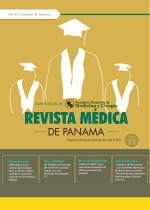Neumonía por COVID19: Valoración por imagen, lo básico [COVID19 pneumonia: Imaging evaluation, the basics]
Autores/as
DOI:
https://doi.org/10.37980/im.journal.rmdp.20201535Resumen
ResumenLa pandemia de COVID-19 ha resultado en una emergencia de salud global. Los estudios de imagen utilizados en esta enfermedad son la radiografía de tórax (RX) y la tomografía computarizada (TC). Ambas modalidades tienen sus hallazgos descritos, pero no son específicos dado que muchas enfermedades pueden producir patrones similares, particularmente las neumonías virales. Los RX de tórax muestra hallazgos consistentes en opacidades alveolares las cuales son múltiples, periféricas, bilaterales y basales, mientras que la tomografía de tórax sus hallazgos más frecuentes son presencia de patrón en vidrio deslustrado, consolidaciones, engrosamiento septal, patrón en empedrado, dilatación bronquial y engrosamiento peri bronquial, broncograma, patrón de halo invertido y patrón de neumonía organizada. Los hallazgos por imagen dependen del tiempo de evolución de la enfermedad ya que en etapas tempranas puede ser normal tanto en la RX como la TC. El riesgo de trombo embolismo pulmonar es alto y más frecuente que en pacientes con COVID-19 negativo.
Abstract
The COVID-19 pandemic has resulted in a global health emergency. The imaging studies used in this disease are chest radiography (CXR) and computed tomography (CT). Both imaging modalities findings have had their findings. These findings described are not specific since many diseases can produce similar patterns. CXR shows somewhat consistent findings consisting of alveolar opacities which are multiple, peripheral, bilateral and basal, while CT the most frequent findings are the presence of grounded glass pattern, consolidations, septal thickening, crazy paving pattern, bronchial dilation and peribronchial thickening, air bronchograms, inverted halo sign and organized pneumonia. Imaging findings depends on the evolution time of the disease since in the early stages both chest radiography and tomography may be normal. The risk for pulmonary embolism is high and more frequent than in patients with negative COVID-19.
Publicado
Número
Sección
Licencia
Derechos autoriales y de reproducibilidad. La Revista Médica de Panama es un ente académico, sin fines de lucro, que forma parte de la Academia Panameña de Medicina y Cirugía. Sus publicaciones son de tipo acceso gratuito de su contenido para uso individual y académico, sin restricción. Los derechos autoriales de cada artículo son retenidos por sus autores. Al Publicar en la Revista, el autor otorga Licencia permanente, exclusiva, e irrevocable a la Sociedad para la edición del manuscrito, y otorga a la empresa editorial, Infomedic International Licencia de uso de distribución, indexación y comercial exclusiva, permanente e irrevocable de su contenido y para la generación de productos y servicios derivados del mismo. En caso que el autor obtenga la licencia CC BY, el artículo y sus derivados son de libre acceso y distribución.






